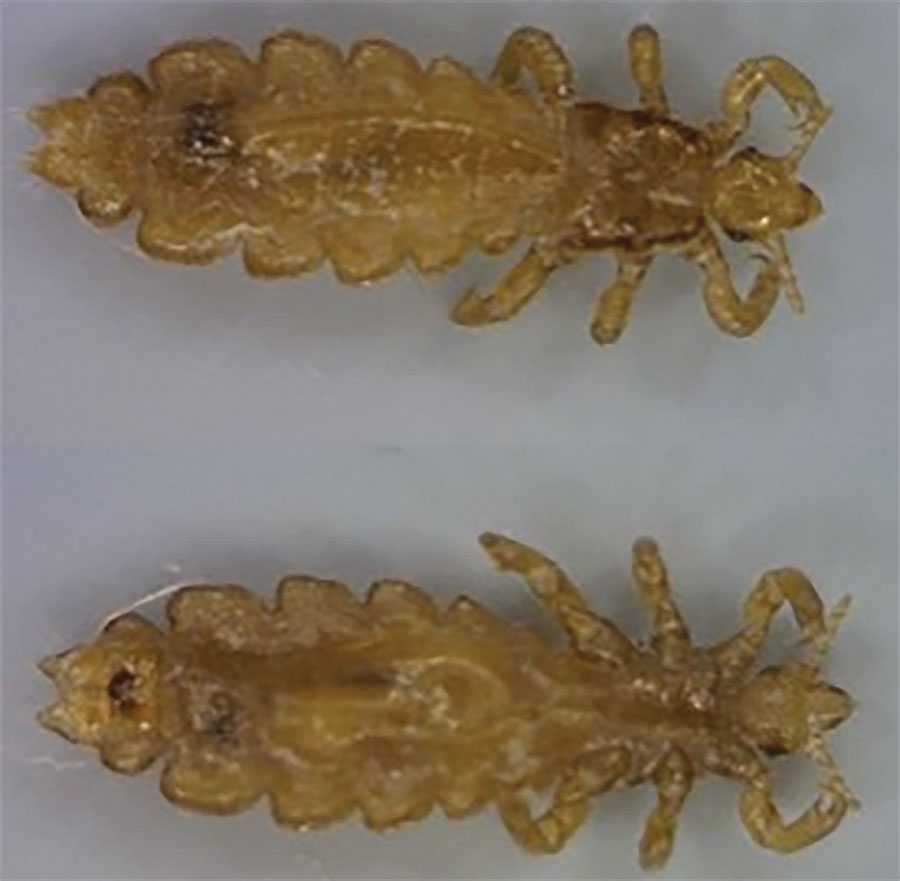Volume 30, Number 7—July 2024
Dispatch
Body Louse Pathogen Surveillance among Persons Experiencing Homelessness, Canada, 2020–2021
Figure 2

Figure 2. Two female body lice, Pediculus humanus humanus, collected from a person experiencing homelessness in inner city Winnipeg, Manitoba, Canada (9).
References
- Boodman C, Wuerz T, Lagacé-Wiens P. Endocarditis due to Bartonella quintana, the etiological agent of trench fever. CMAJ. 2020;192:E1723–6. DOIPubMedGoogle Scholar
- Boodman C, Wuerz T, Lagacé-Wiens P, Lindsay R, Dibernardo A, Bullard J, et al. Serologic testing for Bartonella in Manitoba, Canada, 2010–2020: a retrospective case series. CMAJ Open. 2022;10:E476 LP–E482.
- Boodman C, MacDougall W, Hawkes M, Tyrrell G, Fanella S. Bartonella quintana endocarditis in a child from Northern Manitoba, Canada. PLoS Negl Trop Dis. 2022;16:
e0010399 . DOIPubMedGoogle Scholar - Lam JC, Fonseca K, Pabbaraju K, Meatherall BL. Case report: Bartonella quintana endocarditis outside of the Europe-African gradient: comprehensive review of cases within North America. Am J Trop Med Hyg. 2019;100:1125–9. DOIPubMedGoogle Scholar
- Foucault C, Brouqui P, Raoult D. Bartonella quintana characteristics and clinical management. Emerg Infect Dis. 2006;12:217–23. DOIPubMedGoogle Scholar
- Light JE, Toups MA, Reed DL. What’s in a name: the taxonomic status of human head and body lice. Mol Phylogenet Evol. 2008;47:1203–16. DOIPubMedGoogle Scholar
- Amanzougaghene N, Fenollar F, Raoult D, Mediannikov O. Where are we with human lice? A review of the current state of knowledge. Front Cell Infect Microbiol. 2020;9:474. DOIPubMedGoogle Scholar
- Drali R, Boutellis A, Raoult D, Rolain JM, Brouqui P. Distinguishing body lice from head lice by multiplex real-time PCR analysis of the Phum_PHUM540560 gene. PLoS One. 2013;8:
e58088 . DOIPubMedGoogle Scholar - Bonilla DL, Durden LA, Eremeeva ME, Dasch GA. The biology and taxonomy of head and body lice—implications for louse-borne disease prevention. PLoS Pathog. 2013;9:
e1003724 . DOIPubMedGoogle Scholar - Bonilla DL, Kabeya H, Henn J, Kramer VL, Kosoy MY. Bartonella quintana in body lice and head lice from homeless persons, San Francisco, California, USA. Emerg Infect Dis. 2009;15:912–5. DOIPubMedGoogle Scholar
- Badiaga S, Raoult D, Brouqui P. Preventing and controlling emerging and reemerging transmissible diseases in the homeless. Emerg Infect Dis. 2008;14:1353–9. DOIPubMedGoogle Scholar
- La Scola B, Raoult D. Acinetobacter baumannii in human body louse. Emerg Infect Dis. 2004;10:1671–3. DOIPubMedGoogle Scholar
- Chomel BB, Boulouis H-J, Breitschwerdt EB, Kasten RW, Vayssier-Taussat M, Birtles RJ, et al. Ecological fitness and strategies of adaptation of Bartonella species to their hosts and vectors. Vet Res. 2009;40:29. DOIPubMedGoogle Scholar
- Seki N, Kasai S, Saito N, Komagata O, Mihara M, Sasaki T, et al. Quantitative analysis of proliferation and excretion of Bartonella quintana in body lice, Pediculus humanus L. Am J Trop Med Hyg. 2007;77:562–6. DOIPubMedGoogle Scholar
Page created: May 14, 2024
Page updated: June 22, 2024
Page reviewed: June 22, 2024
The conclusions, findings, and opinions expressed by authors contributing to this journal do not necessarily reflect the official position of the U.S. Department of Health and Human Services, the Public Health Service, the Centers for Disease Control and Prevention, or the authors' affiliated institutions. Use of trade names is for identification only and does not imply endorsement by any of the groups named above.